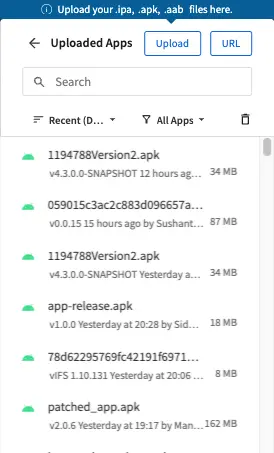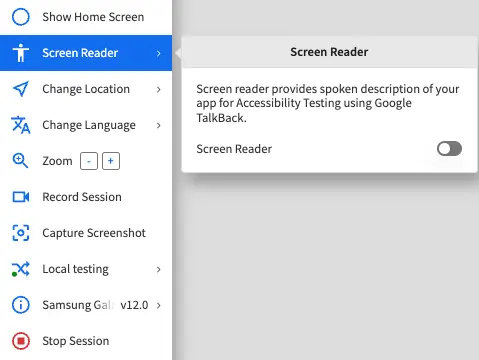Use Screen Reader on Android in App Accessibility
Use the Screen Reader feature on real Android devices in App Accessibility.
Manual accessibility testing is crucial to ensure your mobile apps are fully compliant with Web Content Accessibility Guidelines (WCAG) and accessible to differently-abled users. The TalkBack screen reader on supported real devices provides spoken feedback for Android apps, enabling users with visual difficulties to navigate and interact with apps.
Google TalkBack allows for element-by-element UI navigation, providing spoken descriptions of each UI element as users move through the app. When testing your app with TalkBack, you ensure that users who rely on screen readers can effectively use your app, offering them a fully accessible experience.
Supported Android devices
App Accessibility supports the screen reader feature on the following Android devices:
| Devices | Android Version |
|---|---|
| Google Pixel 6 | Android 12 |
| Samsung Galaxy S22 Plus | Android 12 |
| Samsung Galaxy S24 Ultra | Android 14 |
Start screen reader testing
Follow these steps to turn the Screen Reader on:
-
Go to the App Accessibility dashboard.
-
In the left menu, click Screen Reader.

-
Select your preferred device and OS combination to start a session.
A new device window opens. - In the Select Source prompt, install an app from the Android Play Store or click Uploaded Apps and choose one of the following options:
- Select a previously uploaded app.
- Click Upload to upload your app.
- Click URL to provide a link to your app.

-
On the App Accessibility vertical toolbar, click Screen Reader and turn on the Screen Reader toggle.

A Screen Reader has been enabled successfully notification appears. Start exploring your app with the screen reader to identify any areas for accessibility improvements.
Ensure that audio is enabled on your system to hear the spoken description provided by TalkBack.
If your keyboard shortcuts are not working after enabling the screen reader, click anywhere on the device screen to ensure that the browser focus is on the device.
Navigation when using screen reader
Your app’s end-users accessing your mobile app on an Android device with TalkBack enabled would either navigate your app via using touch gestures or keyboard shortcuts on a Bluetooth keyboard. Navigation behavior on TalkBack (such as moving to the next or previous element or auto-reading from the start of the page) that can be undertaken with these two methods will be referred to using the term “TalkBack actions” from here on.
Both ways are essentially similar in that they undertake TalkBack actions on the device UI such as moving to the next or the previous element or activating/selecting the element in focus. It should make no difference to your app’s accessibility rating whether your end-user is using touch gestures or the Bluetooth keyboard. Once you ensure your mobile app’s WCAG compliance with one, it should work with the other.
For the ScreenReader feature on Android devices, use the following keyboard shortcuts to trigger TalkBack actions:
| Talkback action | MacOS keyboard layout shortcut | Windows keyboard layout shortcut |
|---|---|---|
| Moving to previous/next item | Command + (Left/Right arrow) | Ctrl + (Left/Right arrow) |
| Scroll up/down | Command + (Up/Down arrow) | Ctrl + (Up/Down arrow) |
| Activate / open element | Control + Option + Space | Ctrl + Shift + Space |
| Go back | Esc | Esc |
| Pause or resume speech | Control + Option + Z | Ctrl + Shift + Z |
| Read from next item | Control + Option + P | Ctrl + Shift + P |
| Move up the slider | Control + Option + U | Ctrl + Shift + U |
| Move down the slider | Control + Option + D | Ctrl + Shift + D |
| Go to home screen | Control + Option + H | Ctrl + Shift + H |
| Go to recents | Control + Option + R | Ctrl + Shift + R |
| Go to quick settings | Control + Option + Q | Ctrl + Shift + Q |
| Long click highlighted item | Control + Option + L | Ctrl + Shift + L |
| Go to notifications | Control + Option + N | Ctrl + Shift + N |
| TalkBack menu | Control + Option + T | Ctrl + Shift + T |
| Move to next reading control | Control + Option + J | Ctrl + Shift + J |
| Move to previous reading control | Control + Option + K | Ctrl + Shift + K |
The following is a video demo of the above actions using the shortcuts:
You do not hear the TalkBack audio in the demo videos provided in this guide. However, while testing your app after enabling the Screen Reader feature on App Accessibility, you will hear TalkBack audio.
How to test for end users who use touch gestures on their phones
Any Android device can be seen to have two modes of behavior depending on the kind of action they generate when using touch gestures:
- During regular use.
- When TalkBack is turned on.
For example, during regular usage, a swipe left or swipe right gesture may trigger the following actions, depending on where you are on the device:
- Moves to the previous/next screen on the homepage.
- Move to the previous/next picture in a photo gallery.
When TalkBack is turned on however, the same swipe left or swipe right gesture may trigger a TalkBack action which is moving focus to the previous or the next UI element on the screen.
These two modes of UI actions/behavior are referred to as regular mode and TalkBack mode respectively in this document.
However, even when using TalkBack with the ScreenReader feature in App Accessibility, touch gestures trigger regular mode actions and not TalkBack mode actions, as defined in the official TalkBack documentation page.
Then, how should you test your mobile app accessibility for end users who use touch gestures on Android phones with TalkBack enabled?
The answer is, you don’t have to. Simply ensure that your app is accessible via keyboard navigation on real devices in App Accessibility.
WCAG compliance and accessibility is for ensuring aspects such as:
- UI elements and controls on your app are reachable and in the correct order when traversed in linear order via touch gestures like swipe left/right, or corresponding keyboard shortcuts for moving to previous or next element.
- The description of UI elements and controls on your app is such that it makes sense to a user hearing them via the TalkBack audio readout.
Hence, it makes no difference to your app’s accessibility rating, whether the end user navigates the app via the keyboard, or by using touch gestures when TalkBack is enabled. This is because the underlying ordering of UI elements, their reachability, and their description remains the same. Ensuring that your app is accessible by testing with one mode (keyboard or touch gestures) would ensure that it is accessible even if the end user is using another mode.
Modify TalkBack settings
After you have TalkBack enabled on the device by enabling the ScreenReader feature, you can access and modify TalkBack settings as follows:
- Navigate to Home Screen.
- Click Settings.
- On the Settings menu, click Accessibility.
- On the Accessibility menu, click Installed Apps.
- On the Installed Apps menu, click BSTalkback.
The BSTalkback option is turned on when TalkBack is enabled. - On the BSTalkback menu, click Settings to view or modify your TalkBack settings.
We're sorry to hear that. Please share your feedback so we can do better
Contact our Support team for immediate help while we work on improving our docs.
We're continuously improving our docs. We'd love to know what you liked
We're sorry to hear that. Please share your feedback so we can do better
Contact our Support team for immediate help while we work on improving our docs.
We're continuously improving our docs. We'd love to know what you liked
Thank you for your valuable feedback!